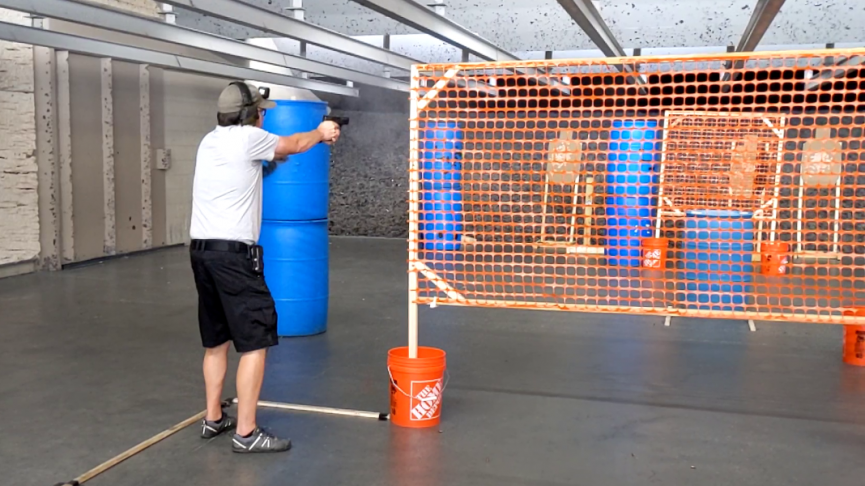Decided to shoot a match with my actual carry gun this month, and honestly I was very happy with it. I’ve been carrying this same M&P Compact for ten years now and I always find it shoots like a full-size gun for me. I shot it the way I carry it, with the flush-fit 12 round mag in the holster and reloading to a 17 rounder. Here’s the match video, with my thoughts on the stages and my shooting below. (Please excuse the copious smoke. I was shooting some uncoated lead practice rounds and didn’t realize just how much more smoky they are than regular Blue Bullets.)
Stage 1
This was a deceptively simple stage. Do you turn and draw to the 8″ plate? Or do you shoot it as you leave the first position? Also, staggering the distance of the targets meant the transitions between them changed from each view. For being a simple 10 round stage, it tested a lot of skills and rewarded arriving in each spot with the gun up and ready to shoot.
This was the first stage for us. I played it safe and went for headshots on the middle target, dropping one point down. I had a mystery mike on the left target, although one bullet hole had a very dark grease ring so it may have been the most perfect double of my life, but I kinda doubt it. Watching the video, all the shots look good, so no idea what happened.
Stage 2
This stage was directly inspired by the “Random Shit” stage from the 2022 Finnish Brutality, simplified a bit. At each barrel you flipped a card to find out which barrel to move to and shoot from next. For being a 12 round stage, it really flustered a lot of people. (Unfortunately there was one scenario where you could end up back at the barrel where you started with both cards flipped up, in which case we told folks to just move to any other barrel and flip a card there. It was not perfectly fair, but it was interesting.)
I ended up winning the stage, in part by shooting one-for-one without makeups and only dropping two points on the challenging partials. My only edge was that the stage brief said you had to flip over the card before leaving the barrel, but once there was one card face-up, I could figure out what the card was going to be and be ready to go that direction as soon as the second card was flipped over instead of reacting to it. A bit of gamesmanship, but it worked.
Stage 3
By putting the shooting position pretty far downrange, this stage became all about wide, precise transitions, in addition to the barrel pickup and reload which always flusters folks who only train to reload off their belt.
This stage went pretty well, and I was right on the edge with some of the fast transitions and picked up two points down on penalties. But overall a good performance. Reloading to the 17 rounders is definitely way faster than the short carry magazines. I kept them loaded all the way to 17 (instead of leaving the mag loaded to only 16 which can make it easier to reload) to mirror how I carry, and I didn’t have any issues with seating on the reload on this stage or the next one.
Stage 4
This was a pretty straightforward USPSA-style field course. The goal with the front left and front right positions was to have an easy open target you could shooting moving into position, but then a harder shot you had to make sure you were controlled for. And at the front right, you either had to shoot right to left, starting on the tux, or shoot the open target first and then have to go right then back left or vice versa, or shoot the tuxedo from the back right corner. These are the kinds of “options” we don’t hear discussed a lot in stages because they are subtle, but I thought it made this stage more complex than it might seem at first.
I was happy with my shooting on this one. If I had been shooting with a dot, I might have tried to shoot the tuxedo on the move, but I definitely chose to play it safe and just shoot a simple right-to-left order in the final position, and be fairly slowed down and stabilized when I did.
Watching the video, it looks like I had a foot fault on the first shot, but I think it might just be a trick of the light. My foot was on the fault line, not touching the other side, but it’s definitely way too close. I picked up a foot fault at the Carolina Classic as well for a similar situation, and I need to make sure I’m not just technically inside the shooting area, but obviously so before I break the shot.
Overall this was great match. We had 30 registered shooters and aside from the one hiccup with stage 2, everything ran smoothly.

